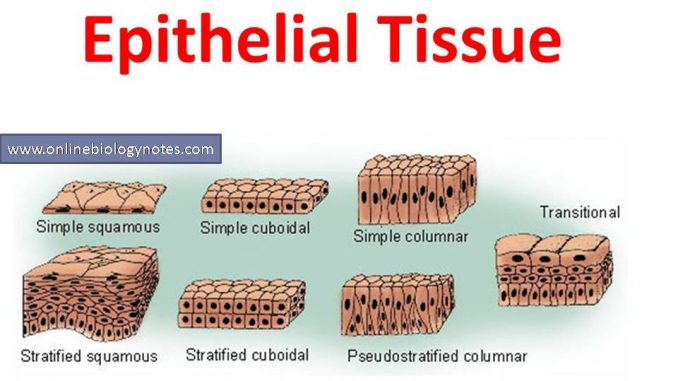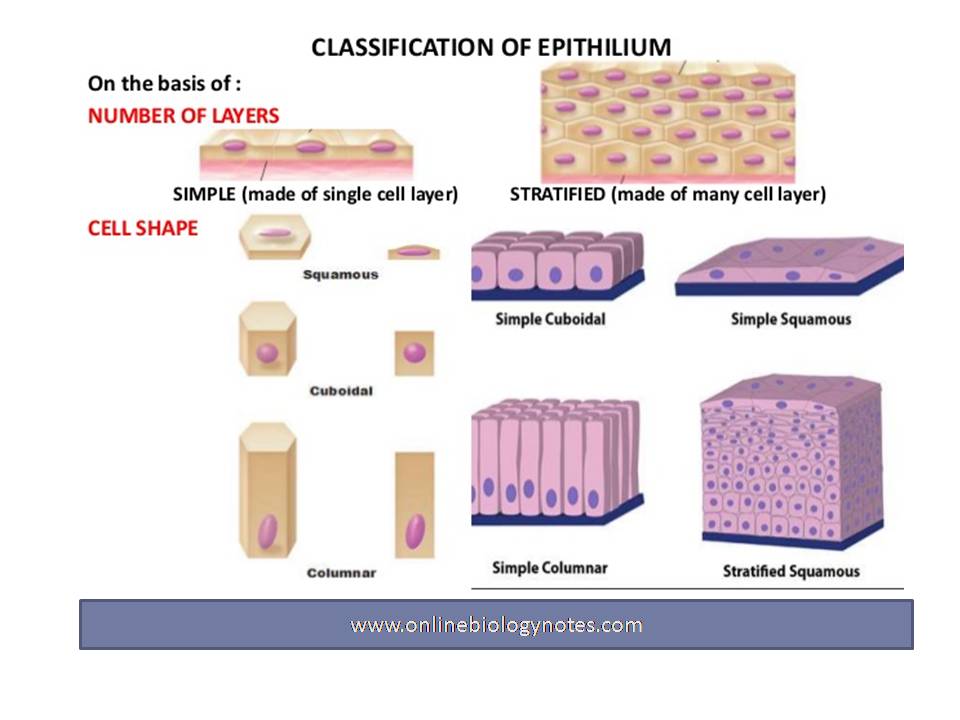
Epithelial tissue: characteristics and classification scheme and types
epithelial tissue
- An epithelium is a sheet of cells that covers a body surface or lines a cavity.
- Epithelium forms the coverings of surfaces of the body such as Skin, Mouth, Nasal cavity (Ectodermal), Lines internal body surface such as GI tract, Lungs, Urinary bladder and vagina (Endodermal) and Lining of blood vessels, lymphatic and heart (Endothelial cells derived from Mesoderm).
- It serves many purposes, including protection, adsorption, excretion, secretion, filtration, and sensory reception.
- Epithelium also serves as glandular epithelium.
- There are two functional types of epithelium: lining epithelium and glandular epithelium.
Characteristics of epithelium tissue
- Polarity- Epithelium is arranged so there is one free surface (apical surface) and one attached surface (basal surface)
- Cellular nature– Cells in epithelium fit closely together side by side and sometimes atop each other to form sheets of cells. These sheets are held together by specialized junctions.
- Supported by connective tissue– Attachment to a layer of connective tissue at the basal surface forms a layer called the basement membrane, an adhesive layer formed by secretions from the epithelial cells and the connective tissue cells.
- Avascular– Epithelium typically lacks its own blood supply.
- Regeneration– Epithelium cells can regenerate if proper nourished.
- Absence of nerves (except for a few axons in the deeper layers)
Classification scheme of epithelial tissue:
Typically epithelial tissue is classified on the basis of arrangement and shape of cells. For naming the tissue types, the arrangement of the cells is stated first, then the shape, and is followed by “epithelium” to complete the naming. For example; Simple Squamous Epithelium.

1. Classification scheme of epithelial tissue on the basis of arrangement of cells
i. Simple epithelium:
- Cells are found in a single layer attached to the basement membrane.
ii. Compound or Stratified epithelium:
- Cells are found in 2 or more layers stacked atop each other.
iii. Pseudo-stratified epithelium:
- Pseudo-stratified epithelium appears to be more than one cell thick since the nuclei lie at different heights, but in fact it is single layer of cells, in contact with the basement membrane
iv. Transitional epithelium:
- cells are rounded and can slide across one another to allow stretching
2. Classification scheme of epithelial tissue on the basis of shape
i. Squamous epithelium: (Latin, squama- scale)
- flat, thin, scale-like cells,
- eg. Endothelium, mesothelium, pericardium, peritonium
ii. Cuboidal epithelium:
- cells that have a basic cube shape.
- Typically the cell’s height and width are about equal.
- Eg. Kidney tubules, thyroid glands, duct of sweat gland
iii. Columnar epithelium:
- tall, rectangular or column shaped cells.
- Typically cells are longer than width.
- Eg. Intestinal lining, gall bladder, ducts of glands
Types of epithelium tissue:
Simple epithelium tissue
- Simple squamous epithelium
- Simple cuboidal epithelium
- Simple columnar epithelium
- Pseudo-stratified epithelium
Compound or Stratified epithelium:
- Stratified squamous epithelium
- Stratified cuboidal epithelium
- Stratified columnar epithelium
- Transitional epithelium
Specialised Epithelium
- Glandular epithelium
- Germinal epithelium
- Sensory epithelium
- Ciliated epithelium
